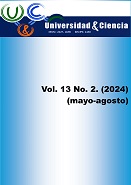Effect of different biostimulants and a physiological activator on performance indicators of common bean
DOI:
https://doi.org/10.5281/zenodo.11359432Keywords:
flowering, plant height, pod, weight, yieldAbstract
The common bean Phaseolus vulgaris is one of the most important legumes for human consumption. With the objective of evaluating the effect of biostimulants and a physiological activator on performance indicators, a research was carried out in the province of Cotopaxi, Ecuador. A randomized block design was used with five treatments, consisting of: T0 = Control without application, T1 = 10 ml biostimulant 1 + 10 ml biostimulant 2, T2 = 20 ml biostimulant 1 + 10 ml biostimulant 2, T3 = 10 ml biostimulant 1 + 10 ml of biostimulant 2 + 10 ml activator (foliar), T4 = 20 ml biostimulant 1 +10 ml biostimulant 2 +20 ml activator (foliar). Percentage of emergence, plant height, length and weight of the root, weight of the aerial part, days to flowering, weight of 100 grains, and yield were evaluated. The results reflected an emergence of 100% of the seedlings after seven days. The plant height, length and root weight indicators reflected the highest values at 60 days, when using the biostimulant combined with the activator. The aerial part of the plant reached the highest weight for T3 (186.23 g). The days to flowering, number of pods, weight of 100 grains, and yield reflected the best results for T2, T3 and T4, the latter reached higher values than 490 Kg/ha-1. The application of the different biostimulants combined with the biological activator increased the morphophysiological indicators and the yield of the bean.
Downloads
References
Agrovigor. (2023). https://dealshaker.oneecosystem.eu/deal/agrovigor-agrovigor-avance-70-one-la-mana-ecuadir-D127FBD41C.
Calero Hurtado, A.; Quintero Rodríguez, E. y Pérez Díaz, Y. (2017). Utilización de diferentes bioproductos en la producción de frijol común (Phaseolus vulgaris L). Agrotecnia de Cuba, 41(1), pp. 17-24. https://www.ausuc.co.cu.
Calero Hurtado, A., Pérez Diaz, Y. y Pérez Reyes, D. (2016). Efecto de diferentes biopreparados combinado con Fitomas E en el comportamiento agroproductivo del frijol común (Phaseolus vulgaris L.). Monfragüe Desarrollo Resiliente, 7(2), 161-176. https://www.monfragueresiliente.com.
Chaves Barrantes, N. F., Néstor Felipe; Polanía, José A.; Muñoz-Perea, Carlos Germán; Rao, Idupulapati M.; Beebe, Stephen E. (2018). Caracterización fenotípica por resistencia a sequía terminal de germoplasma de frijol común. Agronomía Mesoamericana. 29(1), 1-17. https://dx.doi.org/10.15517/ma.v29i1.27618
Dell, J., Morales, D., Jerez, E., Rodríguez, P., Álvarez, I., Martín, R. y Días, Y. (2017). Efecto de dos variantes de riego y aplicaciones foliares de Pectimorf ® en el desarrollo del frijol Phaseolus vulgaris L.). Cultivos Tropicales, 38(3), 129-134. http://scielo.sld.cu/pdf/ctr/v38n3/ctr18317.pdf
Domínguez, A., Darias, R., Martínez, Y., Sosa, M. y Sosa, D. (2021). Selección de variedades de frijol común rojo (Phaseolus vulgaris L.), tolerantes a la sequía en diferentes condiciones de riego en campo. Bionatura, 6(1), 1473-1477. https://www.revistabionatura.com/files/2021.06.01.6.pdf
Ebel, R., Pozas, J.G., Soria, F. y Cruz, J.M. (2017). Manejo orgánico de la milpa: rendimiento de maíz, frijol y calabaza en monocultivo y policultivo. Revista Terra Latinoamericana. 35(2), 149-160. https://www.redalyc.org/articulo.oa?id=57350494006
Escalante Estrada, J. A. S., Rodríguez González, M. T. y Escalante Estrada, Y. I., (2021). Rendimiento de frijol y la aplicación de nitrógeno. Exploratoris: Revista de la Realidad Global, 10(1), 106-112.
García, M., Reyes, D., Zayas, J. y Destrade, R. (2015). Efecto de Pectimorf ® en el enraizamiento in vitro de plantas de ‘FHIA-18’ (Musa AAAB). Biotecnología Vegetal, 15(4), 227-232.
Góngora Martínez, O., Rodríguez Fernández, P. A. y Castillo Ferrer, J. (2020). Comportamiento agronómico de variedades de frijol (Phaseolus vulgaris L.) en las condiciones edafoclimáticas del municipio Songo-La Maya, Santiago de Cuba, Cuba. Ciencia en su PC, 1, 31-45. http://www.redalyc.org/articulo.oa?id=181363107003.
Instituto Nacional de Meteorología e Hidrología. (2021). Las condiciones agrometeorológicas del Cantón La Maná. http://www.inamhi.gob.ec.
Lamz, A. Cárdenas, R.M., Ortiz, R., Alfonzo, L. y Sandrino, A. (2017). Evaluación preliminar de líneas de frijol común (Phaselus vulgaris L.) promisorios para siembras tempranas en Melena del Sur. Cultivos Tropicales, 38(4), 111-118. http://ediciones.inca.edu.cu/index.php/ediciones/article/view/1415.
Lamz, A., Morales, A., Delgado, B. y Florido, M. (2023). Caracterización de 11 líneas de frijol común (Phaseolus vulgaris L.) resistentes a Zabrotes subfasciatus Boheman en Cuba. Biotecnología y Ciencias Agropecuarias, 18(1), 178-190. https://doi.org/10.29059/cienciauat.v18i1.1680.
Lara, D., Costales, D., Nápoles, M. y Falcón, A. (2019). Pectimorf ® y Azofert-F ® en el crecimiento de plantas de frijol (Phaseolus vulgaris L.). Cultivos Tropicales, 40(4), e05. http://ediciones.inca.edu.cu/index.php/ediciuones/article/view/1529.
López, E., Calero, A., Gómez, Y., Gil, Z., Henderson, D. y Jimenez, J. (2017). Efecto agronómico del biosólido en cultivo de tomate (Solanum lycopersicum): control biológico de Rhizoctonia solani. Cultivos Tropicales, 38(1), 13-23. http://ediciones.inca.edu.cu/index.php/ediciones/article/view/1330.
Martínez, L., Maqueira, L., Nápoles, M.C. y Núñez, M. (2017). Efecto de bioestimulantes en el rendimiento de dos cultivares de frijol (Phaseolus vulgaris L.) biofertilizados. Cultivos Tropicales, 38(2), 113-118. http://ediciones.inca.edu.cu/index.php/ediciones/article/view/1373.
Olivera, D., Leiva, L. Calero, A. y Meléndrez, J. F. (2015). Empleo de microorganismos nativos multipropósitos (MNM) en el comportamiento agro-productivo de cultivos hortícolas. Agrotecnia de Cuba, 39(7), 34-42.
Pérez, G., Morgado, Mirna y Villalobos, A. (2022). Caracterización de genotipos de frijol colorado en la Universidad de Ciego de Ávila Máximo Gómez Báez. Universidad & ciencia, Ciego de Ávila, 11(2), 95-109. http://revistas.unica.cu/index.php/uniciencia/article/view/2182.
Quintero, E., Calero, A., Pérez, Y. y Enríquez, L. (2018). Efecto de diferentes bioestimulantes en el rendimiento del frijol común. Revista Centro Agrícola, 45(3), 73-80.
Ravindran, B., Wong, J. W.C., Selvam, A. y Sekaran, G. (2016). Influence of microbial diversity and plant growth hormones in compost and vermicompost from fermented tannery waste. Bioresource Technology, 217, 200-204. http://doi.org./10.1016/j.biortech.2016.03.032.
Rojas, V., Salvador, J.A., Escalante, F., Conde, V., Mejía. J., Díaz, R. (2017). Rendimiento de frijol ayocote y maíz del agrosistema asociado en función del número de plantas por mata. Terra Latinoamericana, 35(3), 219-228. http://doi,org/10.28940/terra.v3513.214.
Ruiz, R., Hernández, S., Vargas, M., y Mayek, N. (2021). Estado actual de los recursos genéticos de Phaseolus coccineus (Fabaceae) en México. Boletín de la Sociedad Argentina de Botánica, 56(3), 289-305. http://doi.org/10.31055/1851.2372.v56.n3.32297.
Yakhin, O.I., Lubyanov, A.A., Yakhin, I.A. y Brown, P.H. (2017). Biostimulants in Plant Science: A Global Perspective. Frontiers in Plant Science, (7), 2049-2056. http://doi.org/10.3389/fpls.2016.02049.
Zhao, H., Pen, T., Zhang, Y., Hu, J., Chao, Y., Hua, Y. y Ke, F. (2017). Effects of vermicompost amendment as a basal fertilizer on soil properties and cucumber yield and quality under continuous cropping conditions in a greenhouse. Journal Soils Sediments, (17), 2718-2730. http://doi.org/10.1007/s11368-017-1744-y.
Downloads
Published
How to Cite
Issue
Section
License
Copyright (c) 2024 Universidad & ciencia

This work is licensed under a Creative Commons Attribution-NonCommercial-ShareAlike 4.0 International License.





















